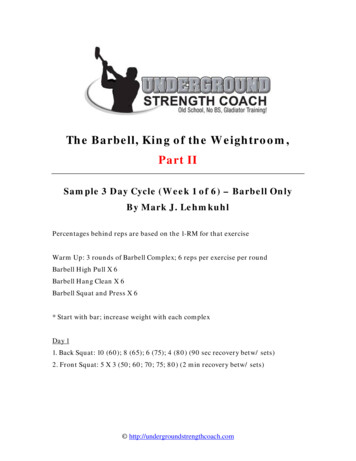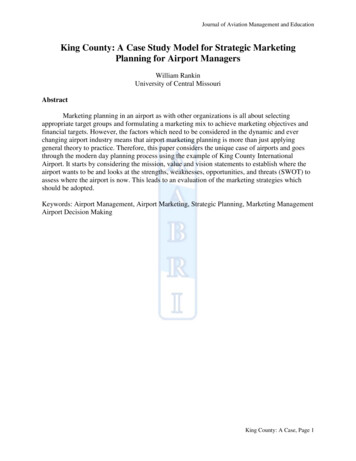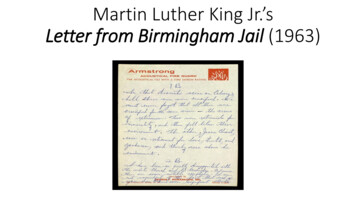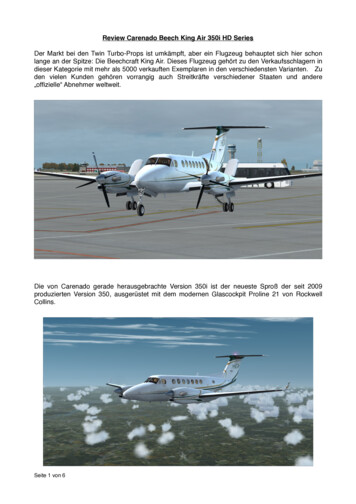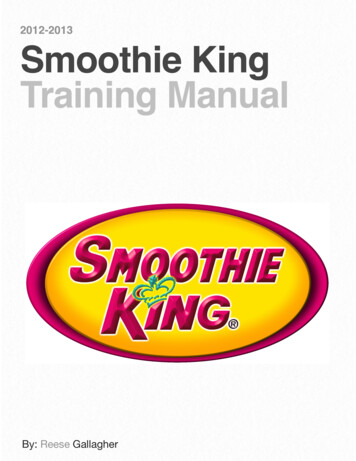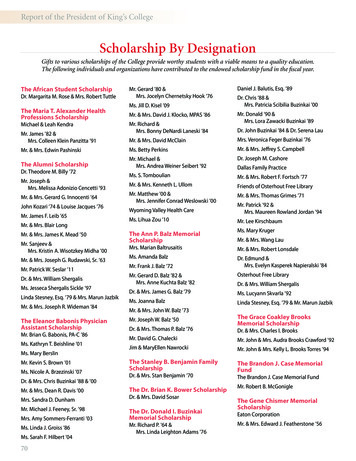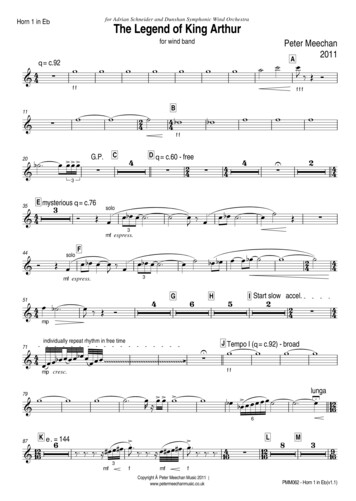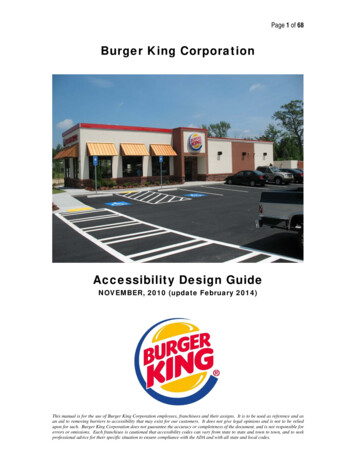
Transcription
Page 1 of 68Burger King CorporationAccessibility Design GuideNOVEMBER, 2010 (update February 2014)This manual is for the use of Burger King Corporation employees, franchisees and their assigns. It is to be used as reference and asan aid to removing barriers to accessibility that may exist for our customers. It does not give legal opinions and is not to be reliedupon for such. Burger King Corporation does not guarantee the accuracy or completeness of the document, and is not responsible forerrors or omissions. Each franchisee is cautioned that accessibility codes can vary from state to state and town to town, and to seekprofessional advice for their specific situation to ensure compliance with the ADA and with all state and local codes.
Page 2 of 681. viations54.Definitions6I.Picture Menus9II.Accessible Parking10III.Accessible Routes14IV.Curb Ramps17V.Ramps20VI.Doors23VII.Queuing Aisles26VIII.Front Service Counter28IX.Self Service Condiments and Drinks Counter29X.Accessible Interior Route, Tables & Seating30XI.Play Areas33XII.Restrooms35Appendix ABurger King 2010 Standards ADA Checklist Version 1.143This manual is for the use of Burger King Corporation employees, franchisees and their assigns. It is to be used as reference and asan aid to removing barriers to accessibility that may exist for our customers. It does not give legal opinions and is not to be reliedupon for such. Burger King Corporation does not guarantee the accuracy or completeness of the document, and is not responsible forerrors or omissions. Each franchisee is cautioned that accessibility codes can vary from state to state and town to town, and to seekprofessional advice for their specific situation to ensure compliance with the ADA and with all state and local codes.
Page 3 of 682. IntroductionBackground:The Americans with Disabilities Act of 1990 is broad sweeping civil rights legislation passed by theUS Congress and signed into law in 1990 by President George Bush. It guarantees certain rights topeople with disabilities, including the ability to gain access to goods and services provided at placesof public accommodation. The ADA applies to all Burger King restaurants, whether they are old(See 4. Definitions: “Readily Achievable”) or new, and includes requirements for all of the elementsidentified in the Burger King 2010 Standards ADA Checklist Version 1.1.The ADA covers more than just the bricks and mortar of our facilities. Policies, practices,procedures, and public accommodations are required to be reasonably modified so as to provideequal services in a non-discriminatory manner to people with disabilities. One example of whichwould be the modification of policies prohibiting animals from restaurants; service animals mayaccompany disabled persons into restaurants. Public accommodations are also required to provideauxiliary aids and services, whenever necessary, to enable effective communication. Examples ofsuch aids for people who are unable to hear can be the use of written communications or picturemenus.People with disabilities currently represent approximately 20% of the population, with that numberincreasing as our society ages. Many groups select a dining location based on the ability to easilyaccommodate a disabled family member or friend. When we consider those (such as mothers withstrollers, people pulling rolling bags etc) who appreciate the wider doors, maneuvering space andramped level change transitions, it is clear that providing clear, safe and convenient access is goodfor all Burger King customers and can result in higher sales and greater customer satisfaction.Responsibilities:As a Burger King Franchisee, you are responsible for ensuring that your facility complies with therequirements of the ADA. This manual is intended to give a brief overview; however, Franchiseesare advised to hire competent legal counsel to help determine the Franchisee’s legal liability.Interpretation of the ADA is in a state of evolution as precedence setting compliance challenges aresettled in and out of court. Burger King Corporation understands its responsibility as a corporatecitizen and has made a serious commitment to making BK restaurants accessible to all customers.It should also be noted that the Burger King Franchisee is required to obtain a new set of BurgerKing prototype plans for every site that is to be developed.It is each individual Franchisee’s responsibility to hire competent professionals to ensurecompliance with all state and local building codes and regulations. This also applies to ADAcriteria. It should be noted that the more restrictive code will always prevail, whether it beLocal, State, or Federal.Use of the Manual:This manual is intended to assist Burger King Franchisees in understanding the responsibilitiesinvolved in providing accessibility for people with disabilities in Burger King restaurants; arequirement of the Americans with Disabilities Act of 1990 (ADA). The manual is also intended toThis manual is for the use of Burger King Corporation employees, franchisees and their assigns. It is to be used as reference and as an aid to removingbarriers to accessibility that may exist for our customers. It does not give legal opinions and is not to be relied upon for such. Burger King Corporationdoes not guarantee the accuracy or completeness of the document, and is not responsible for errors or omissions. Each franchisee is cautioned thataccessibility codes can vary from state to state and town to town, and to seek professional advice for their specific situation to ensure compliance with theADA and with all state and local codes.
Page 4 of 68assist Franchisees and their architects by providing the ADA checklist based on the latest ADAcriteria for elements and spaces typically found in Burger King restaurants. The Burger King 2010Standards ADA Checklist Version 1.1 can and should be used during the design process to insurethat all required elements are included in the design drawings. The Checklist should also be usedduring the punch list phase of the construction project to insure that all elements have beencorrectly constructed and installed.This manual is organized in sections that roughly follow the order of the 2010 ADA Checklist.Understanding the ADA requirements will assist in the development of cost effective solutions thatbenefit all Burger King customers. Definitions and Abbreviations sections are provided at thebeginning of this manual as a quick reference and index. The Burger King 2010 Standards ADAChecklist Version 1.1 is attached as an appendix.This manual is for the use of Burger King Corporation employees, franchisees and their assigns. It is to be used as reference and as an aid to removingbarriers to accessibility that may exist for our customers. It does not give legal opinions and is not to be relied upon for such. Burger King Corporationdoes not guarantee the accuracy or completeness of the document, and is not responsible for errors or omissions. Each franchisee is cautioned thataccessibility codes can vary from state to state and town to town, and to seek professional advice for their specific situation to ensure compliance with theADA and with all state and local codes.
Page 5 of 683. AbbreviationsADAAmericans with Disabilities ActADAAGAmericans with Disabilities Act Accessibility GuidelinesAFFAbove Finish tional Symbol of AccessibilityLav.Lavatory (sink)Max.MaximumMin.MinimumO.C.On Center (a dimension from the center of one object to the center of another)Req or ReqmtsRequired or RequirementsSlope %Rise : RunTyp.TypicalWCWater Closet (toilet)This manual is for the use of Burger King Corporation employees, franchisees and their assigns. It is to be used as reference and as an aid to removingbarriers to accessibility that may exist for our customers. It does not give legal opinions and is not to be relied upon for such. Burger King Corporationdoes not guarantee the accuracy or completeness of the document, and is not responsible for errors or omissions. Each franchisee is cautioned thataccessibility codes can vary from state to state and town to town, and to seek professional advice for their specific situation to ensure compliance with theADA and with all state and local codes.
Page 6 of 684. Definitions“Closed Fist or Flail Hand”Many people have limited use of their hands or limited strength that keeps them from operating items,such as door handles, faucet handles or drinks dispensers. These items must be brought intocompliance so that they can be operated with a closed fist or with a flail hand.Closed Fist Rule: A good way to determine how useable a piece of equipment or hardware is for a broadrange of people with varying hand strength, is to try to operate the unit with a loosely clenched fist or a flailhand. If someone can operate it with a closed fist, it will likely be useable by almost anyone.“Reach Range”Accessible items and controls are required to be located within the wheelchair user’s reach range, andwithin the range of someone with limited arm movement. This range is different depending on thedirection of the approach to the object (front or side), and if it is necessary to reach over another object.In Burger King restaurants, this most often affects our self-serve drinks counter, restrooms, and frontcounter.Front reaches must be no higher than 48 inches and no lower than 15 inches when unobstructed by anobject. The front reach must be no higher than 48 inches when obstructed by an object whose depth isa maximum of 20 inches, or no higher than 44 inches when obstructed by an object whose depth ismore than 20 inches but not more than 25 inches.This manual is for the use of Burger King Corporation employees, franchisees and their assigns. It is to be used as reference and as an aid to removingbarriers to accessibility that may exist for our customers. It does not give legal opinions and is not to be relied upon for such. Burger King Corporationdoes not guarantee the accuracy or completeness of the document, and is not responsible for errors or omissions. Each franchisee is cautioned thataccessibility codes can vary from state to state and town to town, and to seek professional advice for their specific situation to ensure compliance with theADA and with all state and local codes.
Page 7 of 68Side reaches must be no higher than 48 inches and no lower than 15 inches when unobstructed by anobject. The side reach must be no higher than 48 inches when obstructed by an object whose depth isa maximum of 10 inches, or no higher than 46 inches when obstructed by an object whose height is nomore than 34 inches and whose depth is more than 10 inches but not more than 24 inches.“Readily Achievable”The ADA requires 1 companies that provide goods and services to the public to take certain limitedsteps to improve access to existing places of business. This mandate includes the obligation to removebarriers from existing buildings when it is readily achievable to do so. The term “Readily Achievable”means easily accomplishable, and able to be carried out without much difficulty or expense.Many building features that are common in older facilities such as narrow doors, a step, a round doorknob at entrance doors, or a narrow queue aisle are barriers to access by people with disabilities.Removing barriers by ramping a curb, widening an entrance door, installing visual alarms, ordesignating accessible parking spaces is often essential to ensure equal opportunity for people withdisabilities. Because removing these and other common barriers can be simple and inexpensive insome cases and difficult and costly in others, the regulations for the ADA provide a flexible approach to1US Department of Justice’s August 1996 Title III Technical Assistance Manual updateThis manual is for the use of Burger King Corporation employees, franchisees and their assigns. It is to be used as reference and as an aid to removingbarriers to accessibility that may exist for our customers. It does not give legal opinions and is not to be relied upon for such. Burger King Corporationdoes not guarantee the accuracy or completeness of the document, and is not responsible for errors or omissions. Each franchisee is cautioned thataccessibility codes can vary from state to state and town to town, and to seek professional advice for their specific situation to ensure compliance with theADA and with all state and local codes.
Page 8 of 68compliance. This practical approach requires that barriers be removed in existing facilities only when itis readily achievable to do so. The ADA requires existing buildings to meet the ADA's standards fornewly constructed facilities if it is “readily achievable” to do so.The ADA states that individuals with disabilities may not be denied the full and equal enjoyment of thegoods, services, facilities, privileges, advantages, or accommodations that the business provides.This manual is for the use of Burger King Corporation employees, franchisees and their assigns. It is to be used as reference and as an aid to removingbarriers to accessibility that may exist for our customers. It does not give legal opinions and is not to be relied upon for such. Burger King Corporationdoes not guarantee the accuracy or completeness of the document, and is not responsible for errors or omissions. Each franchisee is cautioned thataccessibility codes can vary from state to state and town to town, and to seek professional advice for their specific situation to ensure compliance with theADA and with all state and local codes.
Page 9 of 68I.Picture MenusThe ADA requires “Effective Communication” for all people.Accommodation must be made for customers with low vision or withdifficulty speaking or hearing.Burger King Corporation requires that picture menus be available at theorder counter and at the drivethru window. Signa
Burger King Corporation understands its responsibility as a corporate citizen and has made a serious commitment to making BK restaurants accessible to all customers.
![[EPUB ] The Bob's Burgers Burger Book: Real .](/img/6/the-bob-039-s-burgers-burger-book-real-recipes-for-joke-burgers.jpg)
